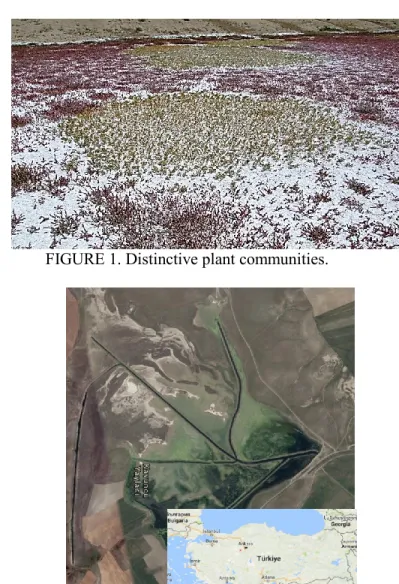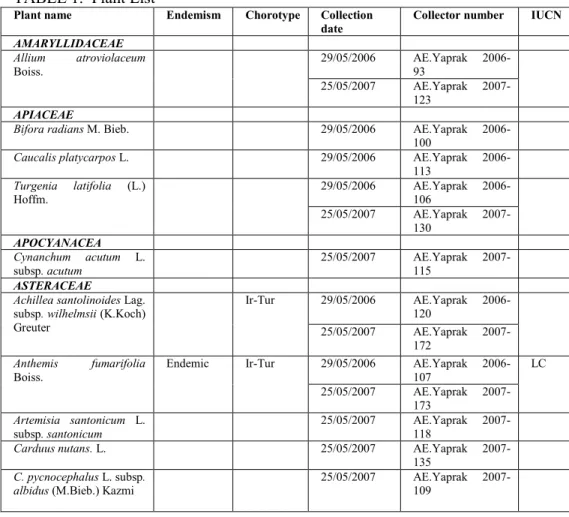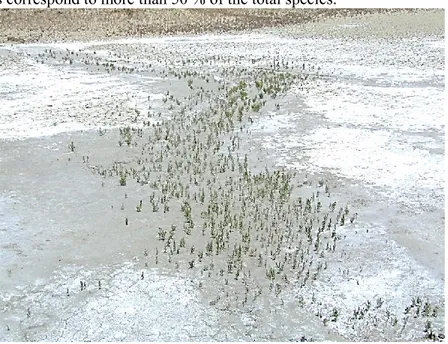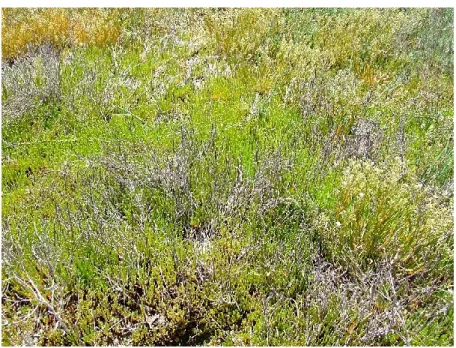Volume 27, Number 2, Pages 55-68 (2018) DOI: 10.1501/commuc_0000000198 ISSN 1303-6025 E-ISSN 2651-3749
http://communications.science.ankara.edu.tr/index.php?series=C
Received by the editors: October 18, 2018; Accepted: December 03, 2018. Key word and phrases: Flora, habitat diversity, saltmarsh, Central Anatolia, Turkey
© 2018 Ankara University Communications Faculty of Sciences University of Ankara Series C: Biology FLORA AND HABITAT DIVERSITY OF KAVUNCU SALTMARSH
G. NILHAN TUG, A.EMRE YAPRAK, S.TUGRUL KORUKLU, UMIT BINGOL Abstract. Turkey attracts attention with its high habitat and species diversity, and one of the important habitat type is saltmarsh. Kavuncu Saltmarsh which is relatively small is located at Central Anatolia between Ankara and Eskişehir and under the threat of some factors like expansion of agricultural areas, pollution from pesticides and fertilizers, and drainage of water for reclamation. There are 102 plant taxa of which 31 are halophytes and 8 are endemic. The plant communities defined from the area are as follows; Thypha domingensis-Phragmites australis, Salicornia perennans, Juncus heldreichianus, Suaeda cucullata-Petrosimonia nigdeensis, Lepidium cartilagineum, Microcnemum coralloides-Aeluropus littoralis, Artemisia santonicum.
1. Introduction
Kavuncu saltmarsh is a characteristic saline habitat with halophytic flora and plant communities. In general, saline areas can be occurred around a salt lake, at the coast of a sea or at areas having high saline water table. Turkey has diverse saline habitats with high plant diversity. Especially Tuz Lake and its surrounding areas are very important for halophyte diversity and endemic species. Saline areas of Turkey can be divided into two major parts; terrestrial and coastal. Terrestrial saline areas can occur around a salt marsh, or at the areas where the saline water table is high and forms seasonal small water bodies. Some of the taxa found at these areas are cosmopolitan species with high ecological tolerance especially against soil salinity other plant species are the ones that have adaptations to high salinity and called as halophytes. The plant species determined from saline areas are about 600 taxa and 30 of them are euhalophytes that cannot survive outside of saline ecosystems [1] and the endemism ratio is about 12,5% [2]. Kavuncu is an inland saline habitat with some fresh water sources and high saline water table, which forms small ponds. In saline ecosystems according to the soil salinity and some biological factors like competition, parasitism etc. plant communities show a characteristic zonation pattern [3, 4, 5, 6, 7, 8, 9, 10, 11]. At Kavuncu, because of
drainage canals and freshwater sources, however zonation is quite like patchwork pattern obvious communities can easily differentiated from each other (Figure 1).
FIGURE 1. Distinctive plant communities.
2. Materials And Methods
During the field studies that started at 2006, and the flora and communities of the area were determined. The study area is situated at the border of Ankara and Eskişehir provinces (Figure 2). The plant specimens were identified according to Flora of Turkey and East Aegean Islands [12, 13], and plant names were checked with the Türkiye Bitkileri Listesi (Damarlı bitkiler) [14]. The plant taxa determined from the study area were listed in Table 1. Plant communities were defined according to the dominance of specific species and also evaluated according to EUNIS habitat classification system.
TABLE 1. Plant List
Plant name Endemism Chorotype Collection date
Collector number IUCN AMARYLLIDACEAE Allium atroviolaceum Boiss. 29/05/2006 AE.Yaprak 2006-93 25/05/2007 AE.Yaprak 2007-123 APIACEAE
Bifora radians M. Bieb. 29/05/2006 AE.Yaprak 2006-100
Caucalis platycarpos L. 29/05/2006 AE.Yaprak 2006-113 Turgenia latifolia (L.) Hoffm. 29/05/2006 AE.Yaprak 2006-106 25/05/2007 AE.Yaprak 2007-130 APOCYANACEA Cynanchum acutum L.
subsp. acutum 25/05/2007 AE.Yaprak 2007-115
ASTERACEAE
Achillea santolinoides Lag.
subsp. wilhelmsii (K.Koch) Greuter Ir-Tur 29/05/2006 AE.Yaprak 2006-120 25/05/2007 AE.Yaprak 2007-172 Anthemis fumarifolia Boiss.
Endemic Ir-Tur 29/05/2006 AE.Yaprak 2006-107 LC 25/05/2007 AE.Yaprak 2007-173 Artemisia santonicum L. subsp. santonicum 25/05/2007 AE.Yaprak 2007-118
Carduus nutans. L. 25/05/2007 AE.Yaprak 2007-135
C. pycnocephalus L. subsp. albidus (M.Bieb.) Kazmi
25/05/2007 AE.Yaprak 2007-109
Centaurea patula DC. Ir-Tur 25/05/2007 AE.Yaprak 2007-137 Cyanus depressus (M. Bieb.) Soják 29/05/2006 AE.Yaprak 2006-90 25/05/2007 AE.Yaprak 2007-133
C. triumfettii (All.) Dostál
ex A.Löve & D. Löve subsp. triumfettii 06/07/2006 AE.Yaprak 2006-134 Scorzonera parviflora Jacq. 29/05/2006 AE.Yaprak 2006-125 25/05/2007 AE.Yaprak 2007-150
S. cana (C.A.Mey.) Griseb.
var. cana 25/05/2007 AE.Yaprak 2007-103 Tragopogon coloratus C.A.Mey. Ir-Tur 25/05/2007 AE.Yaprak 2007-111 BORAGINACEAE Heliotropium europaeum L. Ir-Tur 06/07/2006 AE.Yaprak 2006-136
Lappula patula (Lehm.)
Asch. ex Gürke 29/05/2006 AE.Yaprak 2006-92
Rochelia disperma (L.f.)
K.Koch var. disperma
25/05/2007 AE.Yaprak 2007-142
BRASSICACEAE Alyssum blepharocarpum
T.R.Dudley & Hub.-Mor.
Endemic Ir-Tur 25/05/2007 AE.Yaprak 2007-138
NT
A. linifolium Stephan ex.
Willd. var. linifolium
06/07/2006 AE.Yaprak 2006-140
25/05/2007 AE.Yaprak 2007-156
A. pateri Nyár subsp. pateri
Endemic Ir-Tur LC
Boreava orientalis Jaub. &
Spach
25/05/2007 AE.Yaprak 2007-146
Brassica elongata Ehrh. 06/07/2006 AE.Yaprak 2006-133
25/05/2007 AE.Yaprak 2007-157
Camelina rumelica Velen. 29/05/2006 AE.Yaprak 2006-91
Descurainia sofia (L.)
Webb ex Prantl. subsp.
sofia 25/05/2007 AE.Yaprak 2007-148 Erysimum sisymbrioides C.A. Mey. 25/05/2007 AE.Yaprak 2007-110 Lepidium cartilagineum (J.
Mayer) Thell. subsp.
cartilagineum
25/05/2007 AE.Yaprak 2007-155
L. cartilagineum (J. Mayer) Thell. subsp.
caespitosum (Desv.) Thell.
29/05/2006 AE.Yaprak 2006-121 L. draba L. 25/05/2007 AE.Yaprak2007-158 CAPRIFOLIACEAE Cephalaria syriaca (L.) Syhrad. 06/07/2006 AE.Yaprak 2006-137
Scabiosa rotata M.Bieb. 25/05/2007 AE.Yaprak2007-116
CARYOPHYLLACEAE Gypsophila perfoliata L.
var. perfoliata 06/07/2006 AE.Yaprak 2006-144
Minuartia urumiensis (Bornm.) Bornm. 29/05/2006 AE.Yaprak 2006-95 25/05/2007 AE.Yaprak 2007-160 Spergularia media (L.) C.Presl 29/05/2006 AE.Yaprak 122 2006-CHENOPODIACEAE
Atriplex laevis Ledeb. 06/07/2006 AE.Yaprak 2006-135
25/05/2007 AE.Yaprak2007-102
A. tatarica L. var. tatarica 06/07/2006 AE.Yaprak 2006-150 25/05/2007 AE.Yaprak 2007-163 Chenopodium chenopodioides (L.) Aellen 06/07/2006 AE.Yaprak 2006-157 25/05/2007 AE.Yaprak 2007-165 C. murale L. 06/07/2006 AE.Yaprak 2006-149 25/05/2007 AE.Yaprak 2007-161 Microcnemum coralloides
(Loscos.) J.Pardo subsp.
anatolicum Wagenitz 06/07/2006 AE.Yaprak 2006-154 VU 25/05/2007 AE.Yaprak 2007-167 Petrosimonia brachiata (Pall.) Bunge 29/05/2006 AE.Yaprak 2006-114 06/07/2006 AE.Yaprak 2006-160 25/05/2007 AE.Yaprak 2007-167
P. nigdeensis Aellen Endemic Ir-Tur 29/05/2006 AE.Yaprak 2006-110
06/07/2006 AE.Yaprak 2006-159
25/05/2007 AE.Yaprak 2007-168
2006-Willd. 94
06/07/2006 AE.Yaprak 2006-158
25/05/2007 AE.Yaprak 2007-169
Suaeda altissima Pall. 29/05/2006 AE.Yaprak 2006-97
S. carnosisima Post 06/07/2006 AE.Yaprak 2006-141
25/05/2007 AE.Yaprak 2007-125
S. cucullata Aellen Endemic 06/07/2006 AE.Yaprak 2006-151
VU 25/05/2007 AE.Yaprak
2007-139
CONVOLVULACEAE
Convolvulus arvensis L. Cosm. 29/05/2006 AE.Yaprak 2006-116
C. lineatus L. 29/05/2006 AE.Yaprak 2006-127
25/05/2007 AE.Yaprak 2007-120
Cuscuta balansae Boiss. &
Reuter ex Yunck
06/07/2006 AE.Yaprak 2006-139
CYPERACEAE
Carex divisa Huds. 25/05/2007 AE.Yaprak2007-101
FABACEAE
Alhagi maurorum Medik.
subsp. maurorum Ir-Tur 29/05/2006 AE.Yaprak 2006-98 06/07/2006 AE.Yaprak 2006-161 25/05/2007 AE.Yaprak 2007-119
Astragalus lycius Boiss. Endemic 25/05/2007 AE.Yaprak2007-136 LC
A. mesogitanus Boiss. Endemic Ir-Tur 29/05/2006 AE.Yaprak 2006-115
LC
A. strigillosus Bunge Ir-Tur 29/05/2006 AE.Yaprak 2006-126 25/05/2007 AE.Yaprak 2007-153 Melilotus officinalis (L.) Desr. 25/05/2007 AE.Yaprak 2007-114
Trigonella capitata Boiss. 25/05/2007 AE.Yaprak 2007-117
FRANKENIACEAE
Frankenia hirsuta L. 06/07/2006 AE.Yaprak 2006-138
25/05/2007 AE.Yaprak 2007-126
Juncus heldreichianus
T.Marsson ex Parl. subsp.
orientalis Snogerup 29/05/2006 AE.Yaprak 2006-99 06/07/2006 AE.Yaprak 2006-142 25/05/2007 AE.Yaprak 2007-127 J. inflexus L. subsp. inflexus 29/05/2006 AE.Yaprak 2006-129 06/07/2006 AE.Yaprak 2006-156 25/05/2007 AE.Yaprak 2007-122
Juncus persicus Boiss.
subsp. libanoticus
(J.Thiebaut) Novikov & Snogerup
25/05/2007 AE.Yaprak 2007-142
LAMIACEAE
Lamium orientale (Fisch.
& C.A.Mey.) E.H.L.Krause
Ir-Tur 29/05/2006 AE.Yaprak 2006-102
L. purpureum L. var.
purpureum Euro-Sib 25/05/2007 AE.Yaprak 2007-128
Phlomis armeniaca Willd. Ir-Tur 06/07/2006 AE.Yaprak 2006-145
OROBANCHACEAE
Orobanche oxyloba Beck 06/07/2006 AE.Yaprak 2006-152
PAPAVERACEAE
Fumaria vaillantii Loisel. 29/05/2006 AE.Yaprak 2006-123
Hypecoum pendullum L. 29/05/2006 AE.Yaprak 2006-130
PLANTAGINACEAE Linaria genistifolia (L.)
Mill. var. confertiflora (Boiss.) P.H.Davis Endemic (?) Ir-Tur 29/05/2006 AE.Yaprak 2006-109 LC
Plantago holosteum Scop. Med 06/07/2006 AE.Yaprak 2006-143
25/05/2007 AE.Yaprak 2007-141
P. lanceolata L. 29/05/2006 AE.Yaprak 2006117
POACEAE
Aegilops cylindrica Host Ir-Tur 29/05/2006 AE.Yaprak 2006-101 25/05/2007 AE.Yaprak2007-121 Aeluropus littoralis (Gouan) Parl. 29/05/2006 AE.Yaprak2006-128 25/05/2007 AE.Yaprak2007-154
Agropyron cristatum (L.)
Gaertn. subsp. pectinatum (M. Bieb) Tzvelev var.
pectinatum 25/05/2007 AE.Yaprak 2007-142 Brachiaria eruciformis (sm.) Griseb. 25/05/2007 AE.Yaprak 2007-100
Bromus intermedius Guss. 29/05/2006 AE.Yaprak 2006-104
25/05/2007 AE.Yaprak 2007-166
B. japonicus Thunb. subsp.
japonicas 29/05/2006 AE.Yaprak 2006-118 25/05/2007 AE.Yaprak 2007-152 B. madritensis L. 29/05/2006 AE.Yaprak 2006-131 B. squarrosus L. 29/05/2006 AE.Yaprak 2006-132 B. tectorum L. 06/07/2006 AE.Yaprak 2006-153 25/05/2007 AE.Yaprak 2007-170 Elymus elongatiformis (Drobow) Assadi Ir-Tur 06/07/2006 AE.Yaprak 2006-147
Elymus elongatus (Host)
Runemark subsp. salsus Melderis Endemic 06/07/2006 AE.Yaprak 2006-155 DD 25/05/2007 AE.Yaprak 2007-164 Eremopyrum distans (K.Koch) Nevski Ir-Tur 25/05/2007 AE.Yaprak 2007-113 E. orientale (L.) Jaub.& Spach Ir-Tur 29/05/2006 AE.Yaprak 2006-103 25/05/2007 AE.Yaprak 2007-171 Festuca valesiaca Schleich. ex Gaudin 25/05/2007 AE.Yaprak 2007-145
Hordeum geniculatum All. Euro-Sib 25/05/2007 AE.Yaprak 2007-162
H. murinum L. subsp. leporinum (Link) Arcang
Ir-Tur 29/05/2006 AE.Yaprak 2006-112
25/05/2007 AE.Yaprak 2007-151
Leymus cappadocicus
(Boiss. & Balansa) Melderis
29/05/2006 AE.Yaprak
2006-119 VU
06/07/2006 AE.Yaprak 2006-162
(Cav.) Trin. Ex Steud.
Poa pratensis L. 29/05/2006 AE.Yaprak 2006-124
25/05/2007 AE.Yaprak 2007-149
P. trivialis L. 25/05/2007 AE.Yaprak 2007-147
Puccinellia distans (Jacq.)
Parl. subsp. distans 06/07/2006 AE.Yaprak 2006-146
25/05/2007 AE.Yaprak 2007-159
Stipa ehrenbergiana Trin.
& Rupr.
Ir-Tur 25/05/2007 AE.Yaprak 2007-112
POLYGONACEAE
Polygonum aviculare L. 06/07/2006 AE.Yaprak 2006-148
P. patulum Bieb. subsp. patulum
29/05/2006 AE.Yaprak 2006-105
RANUNCULACEAE
Adonis annua L. Med 25/05/2007 AE.Yaprak 2007-144
A. flammea Jacq. 29/05/2006 AE.Yaprak 2006-108 A. microcarpa DC. 29/05/2006 AE.Yaprak 2006-111 Consolida orientalis (J.Gay) Schrödinger 25/05/2007 AE.Yaprak 2007-131
Nigella segetalis M.Bieb. 25/05/2007 AE.Yaprak 2007-140
RUBIACEAE
Galium verum L. subsp. verum
Euro-Sib 25/05/2007 AE.Yaprak 2007-134
TAMARICACEAE
Tamarix parviflora DC. Med 25/05/2007 AE.Yaprak 2007-124
TYPHACEAE
Typha domingensis Pers. 25/05/2007 AE.Yaprak 2007-129
ZYGOPHYLLACEAE
Zygophyllum fabago L. Ir-Tur 25/05/2007 AE.Yaprak 2007-132
Abbreviations: Cosm: Cosmopolitan, Ir-Tur: Irano-Turanian, Med: Mediterranean, DD: Data Deficient, LC: Least Concern, NT: Near Threaten, VU: Vulnerable.
3. Results
In total, 102 plant species were identified from the area and nearly 30% of them are halophytes. There are 8 endemic species and the endemism ratio is 8%. The richest families are as follows; Poaceae (22 spp.), Asteraceae (11 spp.), Chenopodiaceae (11 spp.), Brassicaceae (11 spp.) and Fabaceae (6 spp.). These 5 families correspond to more than 50 % of the total species.
FIGURE 3. Salicornia perennans community According to the dominance, plant communities were defined as; Typha domingensis-Phragmites australis
Salicornia perennans (Figure 3) Juncus heldreichianus (Figure 4)
Suaeda cucullata- Petrosimonia nigdeensis Lepidium cartilagineum (Figure 5)
Microcnemum coralloides- Aeluropus littoralis Artemisia santonicum
FIGURE 4. Juncus heldreichianus community
The communities defined from the study area were evaluated according to EUNIS Habitat Classification System and the habitats determined from the area are as follows,
D- Mires, bogs and fens
D6- Inland saline and brackish marshes and reedbeds D6.1- Inland salt marshes
D6.16- Interior Cental European and anatolian Salicornia, Microcnemum, Suaeda and Salsola swards
D6.163- Central Eurasian glasswort swards
D6.2- Inland saline or brackish species-poor helophyte beds normally without free-standing water
D6.21- Dry halophile Phragmites bed E- Grasslands and lands dominated by forbs, mosses or lichens
E6- Inland salt steppes
E6.2- Continental inland salt steppes
Especially for the steppic areas, the EUNIS habitat classification is not suits to the saline steppes of the area. They are mainly resembles the Pannonic salt steppes and salt marshes but the geographical distribution is not cover the Anatolia. For this reason, Central Anatolian Salt Steppes should be included as a new habitat type in EUNIS Habitat Classification for the steppes of saline areas at Central Anatolia.
4. Discussion
Agricultural areas and gypsaceous or marly steppes and halophytic areas show different floral and habitat characteristics surround Kavuncu saltmarsh. The study area is a kind of refuge for halophytes because of its distinct location with the other halophytic areas. Even though its importance for biodiversity and genetic source as salt resistance, it is under the influence of heavy agriculture. Halophytic areas are generally low in habitat diversity, eventhough these areas are very important biological diversity areas and endemism centers. Central Eurasian glasswort swards, dry halophile phragmites beds and continental inland salt steppes are the main habitat types according to EUNIS habitat classification system. Central Eurasian glassworth swards are included in a resolution 4 habitat type at a higher level (d 6.1). Continental inland salt steppes are the habitat types
that cover salt steppes and their associated salt-tolerant herbaceous communities outside the mediterranean zone, it has 4 subtypes but the salt steppes around Kavuncu saltmarhes cannot be included in one of these because of the floristic differences. Also, the drainage canals cause the loss of characteristics of soils and water. Saline soils are not suitable for agriculture, by drainage, the salinity was decreased, and by addition of fertilizers, productivity is increased. However, leakage of fertilizers to the water sources cause eutrophication of the shallow ponds, which are the main causes of loss of habitat and species diversity.
References
[1] S. Ghazanfar, E. Altundağ, A. E. Yaprak, J. Osborne, G. N. Tuğ, M. Vural 2014. Halophytes of Southwest Asia. In: Sabkha Ecosystems vol. IV Cash Crop Halophyte and Diversity Conservation Tasks For Vegetation Science, 47, (Springer Science, 2014) 105-133.
[2] A.E.Yaprak, G.N. Tuğ, 2006. Halophytic Endemics of Turkey. In: Ivanova, D. (ed.), Plant, fungal and habitat diversity investigation and conservation. Proceedings of IV Balkan Botanical Congress, Sofia, 20–26 June 2006. pp. 234–238. Institute of Botany, Sofia. ISBN 978-954-9746-14-3.
[3] M.D. Bertness, Interspecific Interactions among High Marsh Perennials in a New England Salt Marsh. Ecology, 72, (1991) 125–137.
[4] M.D. Bertness, A.M. Ellison, Determinants of pattern in a New England salt marsh plant community. Ecological Monographs, 57, (1987) 129–147. [5] M.D. Bertness, P.J. Ewanchuk, Latitudinal and Climate-Driven Variation in
the Strength and Nature of Biological Interactions in New England Salt Marshes. Oecologia, 132, (2002) 392–401.
[6] M.D.Bertness, L. Gough, S.W. Shumway, Salt tolerances 6 and the distribution of plants across a New England salt marsh. Ecology, 72, (1992) 1842–1851.
[7] A.C. Cooper, The Effects of Salinity and Waterlogging on the Growth and Cation Uptake of Salt Marsh Plants. New Phytologist, 90, (1982) 263-275. [8] C.S.B. Costa, J.C. Marangoni, A.M.G. Avezedo, Plant Zonation in
Irregularly Flooded Salt Marshes: Relative Importance of Stress Tolerance and Biological Interactions. Journal of Ecology, 91, (2003) 951-965.
[9] S.C. Pennings, R.M. Callaway, Salt Marsh Plant Zonation: The Relative Importance of Competition and Physical Factors. Ecology, 73, (1992) 681-690.
[10] A.A. Snow, S.W. Vince, Plant Zonation in An Alaskan Salt Marsh: I. Distribution, Abundance and Environmental Factors. Journal of Ecology, 72, (1984) 669-684.
[11] I.A. Ungar, Are Biotic Factors Significant in Influencing the Distribution of Halophytes in Saline Habitats? Botanical Reviews 64, (1998) 176-199. [12] P.H. Davis, Flora of Turkey and East Aegean Islands, vol. 1-9, Edinburgh
University Press, Edinburgh (1965-1988).
[13] A. Güner et al, Flora of Turkey and East Aegean Islands, vol. 11, (Supplement 2) Edinburgh University Press, Edinburgh (2000).
[14] A. Güner, S. Aslan, T. Ekim, M. Vural, M.T. Babaç, (eds.) Türkiye Bitkileri Listesi (Damarlı Bitkiler). Nezahat Gökyiğit Botanik Bahçesi ve Flora Araştırmaları Derneği Yayını, İstanbul (2012).
Current Address: GUL NILHAN TUG: Ankara University, Science Faculty, Biology Department, 06100, Tandoğan, Ankara, Turkey.
E-mail: tug@science.ankara.edu.tr
ORCID: 0000-0002-2702-2387
Current Address: A. EMRE YAPRAK: Ankara University, Science Faculty, Biology Department, 06100, Tandoğan, Ankara, Turkey.
E-mail: eyaprak@science.ankara.edu.tr
ORCID: 0000-0001-6464-2641
Current Address: S. TUGRUL KORUKLU: Ankara University, Science Faculty, Biology Department, 06100, Tandoğan, Ankara, Turkey.
E-mail: koruklu@science.ankara.edu.tr
ORCID: 0000-0002-7440-6818
Current Address: UMIT BINGOL: Ankara University, Science Faculty, Biology Department, 06100, Tandoğan, Ankara, Turkey.
E-mail: bingol@science.ankara.edu.tr
ORCID: 0000-0002-1342-3892



